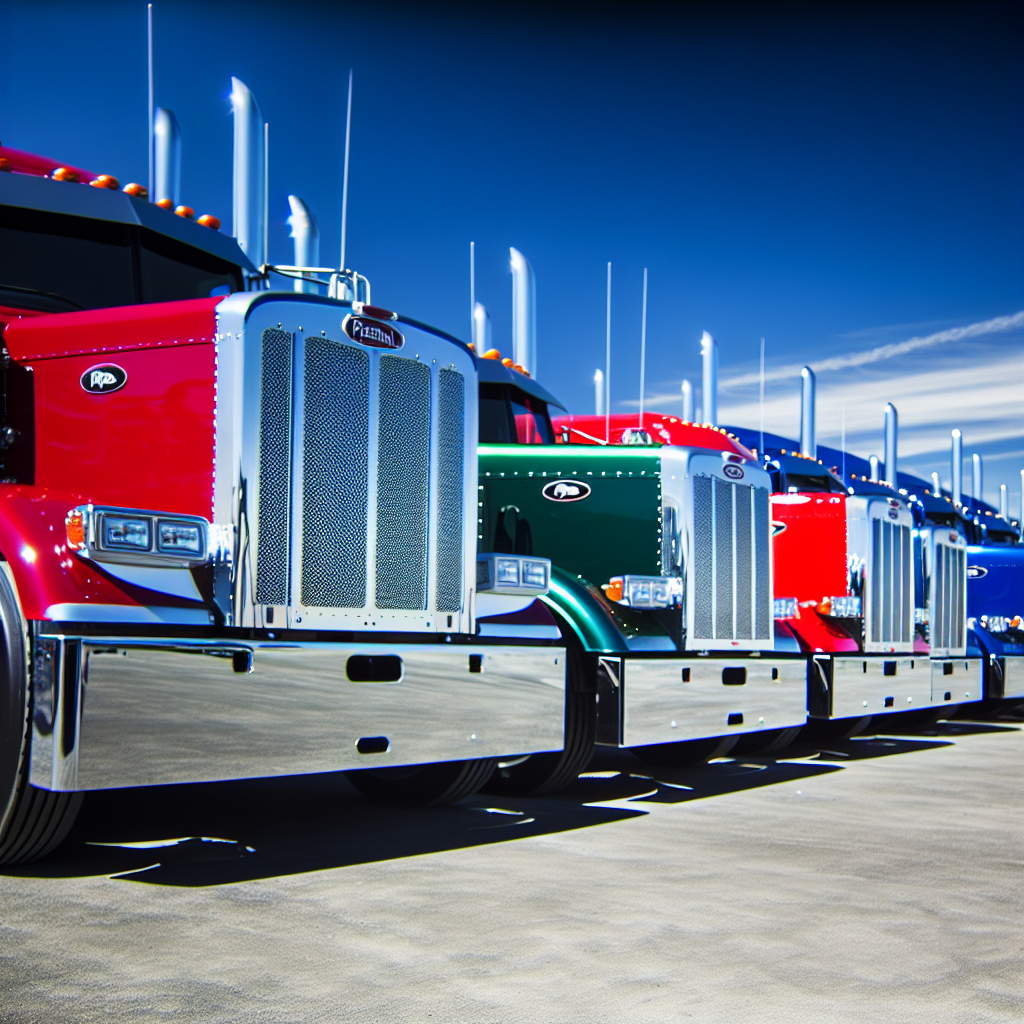In the heart of our communities, where fresh organic milk nourishes families, the importance of in-house fleet truck maintenance cannot be overstated. At Turnage & Sons, a family-run business built on trust and dedication, maintaining a fleet of 29 trucks is more than just a logistical necessity—it’s a commitment to quality, safety, and reliability. Every truck in their fleet represents not only a vehicle but a vital link between local organic milk producers and the consumers who rely on their products.
Following the entrepreneurial spirit of Robbie Turnage, who began this journey in 2006, the meticulous care and proactive maintenance of their trucks ensure that milk deliveries reach grocery shelves promptly and efficiently, rain or shine. The bonds formed within the Turnage operation—between drivers, producers, and families—underscore the emotional resonance of their commitment to excellence.
As Turnage & Sons continues to serve 33 organic producers, every mile driven serves a greater purpose, weaving the threads of community welfare into their daily operations. Efficient maintenance, after all, isn’t just about the trucks; it’s about nurturing the roots of a family legacy while supporting the health of the community.
Effective Maintenance Strategies for In-House Fleet Truck Maintenance
Effective in-house maintenance is crucial for small fleets like Turnage & Sons to ensure vehicle reliability, minimize downtime, and control costs. Here are some best practices and relevant statistics to guide your maintenance strategy:
- Implement Preventive Maintenance Schedules
Regular inspections and servicing can prevent major breakdowns. Organizations adopting preventive maintenance have reported savings of 10% to 15% on repair costs and extended vehicle lifespans by 25% to 50%.
Source - Utilize Predictive Maintenance Technologies
Leveraging telematics and diagnostic tools allows for real-time monitoring of vehicle health, enabling early detection of potential issues. Fleets employing predictive maintenance have achieved a 70% reduction in unexpected failures.
Source - Train Drivers to Identify Early Warning Signs
Educating drivers to recognize and report vehicle issues can lead to early interventions. Fleets with driver training programs have reduced maintenance costs by 10%, saving approximately $100 per truck annually.
Source - Centralize Maintenance Records
Maintaining comprehensive service records aids in tracking maintenance history and planning future services. Fleet management software can streamline this process, helping to identify trends and manage costs effectively.
Source - Monitor Total Cost of Ownership (TCO)
Understanding the full cost associated with each vehicle, including purchase price, maintenance, fuel, and operational expenses, allows for informed decisions on vehicle selection and maintenance strategies. Regular analysis of maintenance trends can identify high-cost vehicles or components, leading to cost-saving measures.
Source - Optimize Vehicle Utilization
Maximizing the active use of each truck reduces idle time and spreads fixed costs over more miles. Implementing route optimization software ensures trucks operate on the most efficient paths, minimizing empty miles and fuel waste.
Source - Leverage Fleet Management Software
Investing in fleet management tools can assist in monitoring vehicle locations, streamlining maintenance schedules, and improving driver performance. Platforms like Azuga, Fleetio, Samsara, and Verizon Connect offer scalable features suitable for small businesses.
Source
At Turnage & Sons, these maintenance strategies are critical to operating their fleet of 29 trucks efficiently. The company emphasizes preventive maintenance schedules, supported by training their drivers to detect early warning signs of vehicle issues. This proactive approach has helped them maintain a reliable fleet that aligns with their mission of delivering quality organic milk to the community.
By adopting structured maintenance practices, Turnage & Sons exemplifies how small fleets can enhance operational efficiency, reduce maintenance costs, and extend vehicle lifespans while contributing to their family legacy and community welfare.


Turnage & Sons Case Study Summary
Turnage & Sons LLC, a family-operated milk-hauling fleet based in Tylertown, Mississippi, has developed a comprehensive maintenance strategy to optimize costs and extend equipment lifespan. Their fleet comprises 29 company-owned Peterbilt trucks, including models 567, 579, 389, and older 379s.
Proactive Maintenance Approach
The company emphasizes proactive maintenance to prevent minor issues from escalating into costly repairs. Robbie Turnage, who leads operations, stated, “It’s a whole lot cheaper for me to fix it right then and there… Make necessary adjustments at the first sign of trouble instead of allowing the issue to become a major repair. This not only saves money but also time.“
Regular Service Intervals
To maintain optimal performance, each truck undergoes servicing every 15,000 miles. This routine includes comprehensive checks and preventive measures to ensure reliability.
In-House Repairs and Driver Collaboration
Approximately 95% of the fleet’s maintenance is conducted in-house, allowing for direct oversight and cost control. Drivers play a crucial role by promptly reporting any irregularities, enabling immediate attention to potential issues. This collaborative approach helps avoid expensive roadside repairs and minimizes downtime.
Investment in Diagnostic Tools
To enhance maintenance efficiency, Turnage & Sons has invested in diagnostic software, such as Paccar’s Davie Diagnostic Software. This tool facilitates in-house fault code diagnosis, enabling the team to address issues promptly and accurately.
By implementing these strategies, Turnage & Sons effectively balances operational costs with equipment longevity, ensuring reliable service to their customers.
Reporting Issues: A Crucial Responsibility
Drivers play a key role in maintaining the fleet. They perform pre-trip and post-trip inspections that check important parts such as brakes, tires, and lights. These inspections often reveal minor issues. If these issues are ignored, they could lead to costly repairs later. Robbie Turnage points out that fixing problems right away saves a lot of money. He says, “It’s a whole lot cheaper for me to fix it right then and there.“
When drivers see something wrong, they document it in a Driver Vehicle Inspection Report (DVIR). They must also tell the maintenance team immediately. This process ensures drivers are involved in maintenance so that any issues are recorded and fixed quickly.
Driver Experiences on the Frontline
At Turnage & Sons, drivers care about vehicle upkeep. They value the focus on in-house maintenance, which makes up about 95% of the fleet’s service. This approach helps build trust between drivers and the maintenance team about the reliability of their trucks. Many drivers feel more responsible knowing their observations help ensure the fleet is safe and efficient.
Additionally, the company has invested in advanced diagnostic tools like Paccar’s Davie Diagnostic Software. This technology enables drivers to report problems easily. They can be sure these issues will be addressed quickly, often before they worsen. This technology empowers drivers to take ownership of their role in maintaining the fleet.
| Maintenance Task | Ideal Interval | Suggested Inspection Actions | Repairs Needed |
|---|---|---|---|
| Preventive Maintenance | Every 15,000 miles | Oil changes, fluid level checks, tire rotation | Address any leaks or issues |
| Vehicle Inspections | Monthly | Brake checks, light inspections, battery tests | Replace worn brake pads |
| Tire Maintenance | Every 10,000 miles | Tire rotation and pressure checks | Replace damaged tires |
| Brake System Check | Every 30,000 miles | Inspect brake pads, rotors, and fluid levels | Repair calipers as needed |
| Fluid Changes (Coolant, Transmission) | 2 years or 30,000 miles | Check all fluid levels, change if dirty | Flush and replace as necessary |
| Annual Comprehensive Inspection | Annually | Full vehicle diagnostics and mechanical checks | Major repairs as indicated |
Cost Optimization Techniques in Fleet Maintenance
Cost optimization in fleet maintenance can significantly enhance profitability and operational efficiency. Turnage & Sons, a family-operated milk-hauling fleet, illustrates effective methods in this domain by employing preventive, predictive, and seasonal maintenance strategies to manage their fleet of 29 trucks effectively.
Preventive Maintenance
Preventive maintenance involves regular, scheduled service aimed at keeping vehicles in prime condition and preventing major breakdowns. This strategy helps to extend vehicle lifespans, enhance safety, and reduce unexpected failures. Actions typically include routine oil changes, tire rotations, brake inspections, and fluid checks. The cumulative savings on maintenance costs can range from 10% to 15%, along with increased vehicle reliability and performance. source
Predictive Maintenance
Utilizing predictive maintenance techniques allows fleets to monitor vehicle health in real-time, forecasting potential failures before they occur. This method reduces unplanned downtime by as much as 50% and can lead to a 20% cut in overall maintenance costs, ultimately enhancing fuel efficiency by identifying issues like underinflated tires. source
Seasonal Checks
Seasonal maintenance ensures vehicles are ready for changing weather conditions. This includes checking heating and cooling systems, inspecting tires, and ensuring fluids are suitable for seasonal changes. Regular seasonal inspections help mitigate weather-related breakdowns and maintain operational efficiency. source
Through careful implementation of these strategies, Turnage & Sons not only optimizes their maintenance costs but also assures reliable service delivery to their organic milk producers, which is integral to their business model.
Conclusion
In summary, Turnage & Sons’ approach to fleet management exemplifies a harmonious blend of effective maintenance practices that any fleet manager can apply. By prioritizing preventive maintenance, leveraging driver involvement, and utilizing technology like telematics and diagnostic tools, they have achieved a reliable and cost-effective operation. These strategies not only enhance vehicle longevity and performance but also foster a culture of responsibility among drivers, who play an essential role in the maintenance process.
As you reflect on your own fleet management strategies, consider adopting similar practices. Implementing a structured maintenance schedule, engaging your drivers in the upkeep of vehicles, and utilizing modern technology can lead to significant improvements in efficiency and cost management. Emulating the successful practices of Turnage & Sons will not only strengthen your fleet’s performance but also support the broader community by ensuring that your operations run smoothly and effectively.
User Adoption of Best Maintenance Practices in Fleets
The implementation of best maintenance practices among small and mid-sized truck fleets, akin to Turnage & Sons, shows a diverse range of statistics that highlight both progress and challenges:
- Telematics Adoption: As of 2022, only 37% of small fleets have integrated telematics into their operations. This is a stark contrast to 51% for medium fleets and 54% for large fleets, indicating smaller fleets lag behind in technological adoption. source
- Predictive Maintenance Benefits: Fleets that have adopted predictive maintenance practices report significant improvements, with 60% experiencing fewer preventable breakdowns and 62% reporting reduced unplanned downtime. This illustrates the effectiveness of predictive strategies in enhancing reliability. source
- Maintenance Outsourcing Trends: A notable trend is that 41% of fleets are now outsourcing 90% or more of their maintenance budgets to external providers, including leasing companies and OEMs, which can impact the in-house maintenance culture. source
- Driver Resistance to Monitoring: A challenge remains with 37% of fleet operators reporting driver resistance to vehicle monitoring systems. This resistance can hinder the adoption of technologies meant to improve maintenance and operational efficiency. source
These insights reveal the current landscape of maintenance practice adoption, underscoring areas where small fleets like Turnage & Sons can improve efficiency and effectiveness in their operations.
Effective Maintenance Strategies for In-House Fleet Truck Maintenance
Effective in-house maintenance is crucial for small fleets like Turnage & Sons to ensure vehicle reliability, minimize downtime, and control costs. Here are some best practices and relevant statistics to guide your maintenance strategy:
-
Implement Preventive Maintenance Schedules
Regular inspections and servicing can prevent major breakdowns. Organizations adopting preventive maintenance have reported savings of 10 to 15 percent on repair costs. Extended vehicle lifespans by 25 to 50 percent. Source -
Utilize Predictive Maintenance Technologies
Leveraging telematics and diagnostic tools allows for real-time monitoring of vehicle health. Fleets employing predictive maintenance have achieved a 70 percent reduction in unexpected failures. Source -
Train Drivers to Identify Early Warning Signs
Educating drivers to recognize and report vehicle issues can lead to early interventions. Fleets with driver training programs have reduced maintenance costs by 10 percent, saving approximately $100 per truck annually. Source -
Centralize Maintenance Records
Maintaining comprehensive service records aids in tracking maintenance history. Fleet management software can streamline this process, helping to identify trends and manage costs effectively. Source -
Monitor Total Cost of Ownership (TCO)
Understanding the full cost associated with each vehicle, including purchase price, maintenance, fuel, and operational expenses, allows for informed decisions. Regular analysis of maintenance trends can identify high-cost vehicles or components. Source -
Optimize Vehicle Utilization
Maximizing the active use of each truck reduces idle time and spreads fixed costs over more miles. Implementing route optimization software ensures trucks operate on the most efficient paths. Source -
Leverage Fleet Management Software
Investing in fleet management tools can assist in monitoring vehicle locations and improving driver performance. Platforms like Azuga, Fleetio, Samsara, and Verizon Connect are suitable for small businesses. Source
At Turnage & Sons, these maintenance strategies are critical to operating their fleet of 29 trucks efficiently. The company emphasizes preventive maintenance schedules supported by training their drivers to detect early warning signs of vehicle issues. This proactive approach has helped them maintain a reliable fleet that aligns with their mission of delivering quality organic milk to the community.
By adopting structured maintenance practices, Turnage & Sons exemplifies how small fleets can enhance operational efficiency, reduce maintenance costs, and extend vehicle lifespans while contributing to their family legacy and community welfare.
Cost Optimization Techniques in Fleet Maintenance
Cost optimization in fleet maintenance can significantly enhance profitability and operational efficiency. Turnage & Sons illustrates effective methods in this domain by employing preventive, predictive, and seasonal maintenance strategies to manage their fleet of 29 trucks effectively.
-
Preventive Maintenance
Regular, scheduled service aimed at keeping vehicles in prime condition and preventing major breakdowns. Actions typically include routine oil changes, tire rotations, brake inspections, and fluid checks. Cumulative savings on maintenance costs can range from 10 to 15 percent. Source -
Predictive Maintenance
Allows fleets to monitor vehicle health in real-time, forecasting potential failures before they occur. This method reduces unplanned downtime by as much as 50 percent and leads to a 20 percent cut in overall maintenance costs. Source -
Seasonal Checks
Ensures vehicles are ready for changing weather conditions, including checking heating and cooling systems. Regular seasonal inspections help mitigate weather-related breakdowns. Source
Through careful implementation of these strategies, Turnage & Sons optimizes their maintenance costs, assuring reliable service delivery to their organic milk producers, integral to their business model.

A well-maintained fleet of Peterbilt trucks, showcasing their bright colors and pristine condition in a sunny outdoor setting. The image emphasizes the importance of fleet maintenance and quality truck care in the transportation industry.
User Adoption of Best Maintenance Practices in Fleets
The implementation of best maintenance practices among small and mid-sized truck fleets, akin to Turnage & Sons, shows a diverse range of statistics that highlight both progress and challenges:
-
Telematics Adoption: As of 2022, only 37% of small fleets have integrated telematics into their operations. This is a stark contrast to 51% for medium fleets and 54% for large fleets, indicating smaller fleets lag behind in technological adoption.
Source -
Predictive Maintenance Benefits: Fleets that have adopted predictive maintenance practices report significant improvements, with 60% experiencing fewer preventable breakdowns and 62% reporting reduced unplanned downtime. This illustrates the effectiveness of predictive strategies in enhancing reliability.
Source -
Maintenance Outsourcing Trends: A notable trend is that 41% of fleets are now outsourcing 90% or more of their maintenance budgets to external providers, including leasing companies and OEMs, which can impact the in-house maintenance culture.
Source -
Driver Resistance to Monitoring: A challenge remains with 37% of fleet operators reporting driver resistance to vehicle monitoring systems. This resistance can hinder the adoption of technologies meant to improve maintenance and operational efficiency.
Source
These insights reveal the current landscape of maintenance practice adoption, underscoring areas where small fleets like Turnage & Sons can improve efficiency and effectiveness in their operations.
Importance of Preventive Maintenance in Fleet Management
Preventive maintenance (PM) is crucial in fleet management, offering significant benefits in cost reduction, vehicle uptime, and operational efficiency. Key advantages include:
-
Cost Reduction: Implementing PM programs can lead to substantial savings, with fleets reporting 20% less downtime.
Source -
Operational Efficiency: Predictive maintenance technologies can achieve up to a 45% reduction in downtime.
Source -
Maintenance Cost Management: By proactively maintaining vehicles, fleets can mitigate unexpected repair expenses.
Source -
Vehicle Reliability: Comprehensive PM metrics can lead to 94% vehicle reliability rates.
Source
Driver Involvement in Fleet Maintenance
In 2022, driver involvement in fleet maintenance was critical for enhancing vehicle performance and safety with key findings:
-
Fleet Safety Report Findings: Fleets reported an average of 4.5 accidents per driver annually, primarily attributing driver error to maintenance concerns.
Source -
Shifts in Fleet Manager Priorities: A survey indicated a 39% increase in fleet managers emphasizing driver training related to vehicle safety and operation.
Source -
Reduction in Maintenance Costs: 60% of fleet managers noted that upskilling drivers improved vehicle handling and reduced maintenance costs.
Source -
Adoption of Advanced Safety Features: 71% of fleets implemented new safety features to reduce accidents, demonstrating the financial benefits of proactivity in maintenance practices.
Source
These findings emphasize the integral role of driver engagement in maintenance processes, leading to improved safety, efficiency, and cost management in fleet operations.


